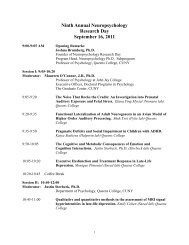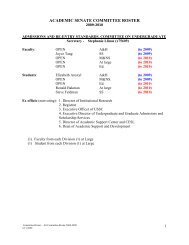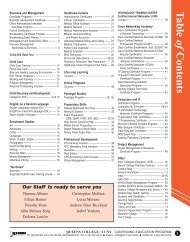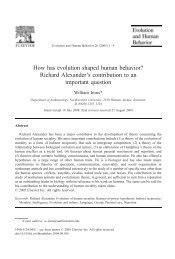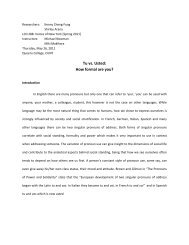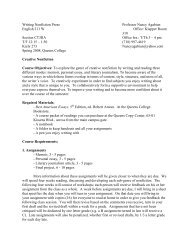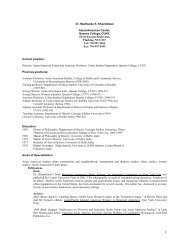Lahti, D. C. & Weinstein, B. S. 2005. The better angels of our nature
Lahti, D. C. & Weinstein, B. S. 2005. The better angels of our nature
Lahti, D. C. & Weinstein, B. S. 2005. The better angels of our nature
Create successful ePaper yourself
Turn your PDF publications into a flip-book with our unique Google optimized e-Paper software.
Evolution and Human Behavior 26 (2005) 47–63<br />
<strong>The</strong> <strong>better</strong> <strong>angels</strong> <strong>of</strong> <strong>our</strong> <strong>nature</strong>: group stability and the<br />
evolution <strong>of</strong> moral tension B<br />
David C. <strong>Lahti</strong> a, *, Bret S. <strong>Weinstein</strong> b<br />
a Program in Organismic and Evolutionary Biology, Morrill Science Center, University <strong>of</strong> Massachusetts, Amherst,<br />
MA 01003, United States<br />
b <strong>The</strong> Evergreen State College, Lab II, 2700 Evergreen Parkway NW, Olympia, WA 98505, United States<br />
Initial receipt 3 November 2003; final revision received 2 September 2004<br />
Abstract<br />
Moral systems require individuals to act in service to their social groups. Despite the human tendency<br />
to view moral norms as invariant and constantly deserving <strong>of</strong> adherence, we vary not only in the moral<br />
norms that we espouse but also in the degree to which <strong>our</strong> behavior reflects those norms. Nevertheless,<br />
moral systems exhibit patterns and complexity that suggest the action <strong>of</strong> natural selection. We propose<br />
that much observed variation in commitment to the group can be explained by a rule <strong>of</strong> stabilitydependent<br />
cooperation, where the adaptive level <strong>of</strong> individual commitment varies inversely with the<br />
stability <strong>of</strong> the social group. This hypothesis is rooted in the understanding that humans are caught in an<br />
evolutionary trade-<strong>of</strong>f between two methods <strong>of</strong> increasing reproductive success: competing with fellow<br />
group members, and increasing the stability <strong>of</strong> the group relative to other groups. If cooperation is<br />
stability dependent, however, human groups in times <strong>of</strong> high stability and low cooperation may be<br />
susceptible to fast-acting extrinsic threats, as well as self-destructive competitive races to the bottom. In<br />
light <strong>of</strong> this, we hypothesize that the absolutism and unchangeableness commonly attributed to moral<br />
norms serve a group stability insurance function and we present predictions from this hypothesis.<br />
D 2005 Elsevier Inc. All rights reserved.<br />
Keywords: Morality; Evolution; Intergroup competition; Cooperation; Altruism<br />
B <strong>The</strong> authors contributed equally to this paper.<br />
* Corresponding author.<br />
E-mail addresses: lahti@bio.umass.edu (D.C. <strong>Lahti</strong>)8 bretw@evergreen.edu (B.S. <strong>Weinstein</strong>).<br />
1090-5138/04/$ – see front matter D 2005 Elsevier Inc. All rights reserved.<br />
doi:10.1016/j.evolhumbehav.2004.09.004
48<br />
D.C. <strong>Lahti</strong>, B.S. <strong>Weinstein</strong> / Evolution and Human Behavior 26 (2005) 47–63<br />
1. Introduction<br />
We are not enemies, but friends. We must not be enemies. Though passion may have strained<br />
it must not break <strong>our</strong> bonds <strong>of</strong> affection. <strong>The</strong> mystic chords <strong>of</strong> memory, stretching from every<br />
battlefield and patriot grave to every living heart and hearthstone all over this broad land, will<br />
yet swell the chorus <strong>of</strong> the Union, when again touched, as surely they will be, by the <strong>better</strong><br />
<strong>angels</strong> <strong>of</strong> <strong>our</strong> <strong>nature</strong>.<br />
Abraham Lincoln. Second Inaugural Address (1861)<br />
<strong>The</strong> history <strong>of</strong> evolutionary approaches to morality has been characterized by debate<br />
between those who claim that bevolution has, as a matter <strong>of</strong> fact, constructed human<br />
beings to act for the community goodQ (Richards, 1987, pp. 623–624; see also Ruse,<br />
1986; Sober & Wilson, 1998) and a diverse opposition maintaining either that morality is<br />
selectively neutral or that it requires us to combat the evolutionary process and brebel<br />
against the tyranny <strong>of</strong> the selfish replicatorsQ (Dawkins, 1976; see also Huxley, 1894;<br />
Williams, 1988). Despite the productivity <strong>of</strong> this discussion (Maienschein & Ruse, 1999),<br />
this paper argues that neither general perspective is sufficiently explanatory; moral action<br />
is not always adaptive, but neither is it neutral or maladaptive. We argue instead that the<br />
propensity for moral deliberation is the fitness enhancing characteristic, any given moral<br />
action shifting between adaptive and maladaptive, depending on context. This paper draws<br />
attention to the significant variation that humans exhibit in individual commitment to moral<br />
norms and proposes that the variation represents generally adaptive responses to dynamic<br />
social environments.<br />
Although psychologists are intensely aware <strong>of</strong> the importance <strong>of</strong> social influences on<br />
morality, they are less aware <strong>of</strong> whether and how individual commitment to moral<br />
responsibility varies with societal variables (Hartup & van Lieshout, 1995). This gap provides<br />
an opening for hypotheses that predict empirical trends based on an evolutionary consideration<br />
<strong>of</strong> the <strong>nature</strong> <strong>of</strong> morality. This paper presents two principles that predict variability<br />
in individual commitment to moral norms as a function <strong>of</strong> one’s perceived social context.<br />
A background assumption for this discussion is that a moral rule tends to be manifest in<br />
consciousness as absolute, in two senses. First, when people promote one alternative as<br />
morally correct, they imply that it is superior to all others in some general way. Regardless <strong>of</strong><br />
<strong>our</strong> actions or desires, we tend to treat moral rules as deserving <strong>of</strong> absolute adherence.<br />
Second, humans tend to consider moral rules absolute in the sense that they carry an<br />
implication <strong>of</strong> permanence across time and space. Despite moral variation within and<br />
between individuals, humans tend to operate under the assumption <strong>of</strong> an underlying truth to<br />
moral rules that does not change (Mackie, 1981, chap. 1). This idea that moral absolutism is<br />
widespread and general is a refutable psychological and sociological hypotheses. If morals<br />
are deemed absolute in the first sense (deserving <strong>of</strong> absolute adherence), people should<br />
consistently endorse alternatives that they deem morally right, even if their behavior or<br />
desires conflict with these moral precepts; and if morals are deemed absolute in the second<br />
sense (invariable in time and space), people should tend to evaluate the attitudes and<br />
behaviors <strong>of</strong> others according to their own moral belief systems, without regard for cultural or<br />
historical differences.
D.C. <strong>Lahti</strong>, B.S. <strong>Weinstein</strong> / Evolution and Human Behavior 26 (2005) 47–63 49<br />
2. Commitment to moral rules varies<br />
<strong>The</strong> central problem to be addressed in this paper is that, despite moral absolutism,<br />
people’s lives exhibit variation in commitment and adherence to the moral rules that they<br />
recognize. Humans deliberate, calculate, and <strong>of</strong>ten struggle—sometimes adhering to the rules,<br />
sometimes not. Perhaps, the central paradox <strong>of</strong> morality is the fact that behavior does not<br />
always match the moral rules espoused by the agent. Moral rules are considered absolute, but<br />
adherence is facultative.<br />
When social and natural scientists have asked why this apparent incongruity exists, their<br />
answers <strong>of</strong>ten fall into two broad categories. One general solution is to view moral rules as<br />
contrary to self-interest, such that the two are continually in opposition. <strong>The</strong> other, perhaps<br />
more common, solution is to see morality as always consistent with globally calculated selfinterest,<br />
and <strong>our</strong> moral struggles and deliberation as internal conflict between short- and longterm<br />
self-interest. Both these alternatives interpret variation in commitment to moral norms as<br />
a maladaptive by-product <strong>of</strong> a weakness or inconsistency in human psyche. Either the<br />
difficulty <strong>of</strong> self-sacrifice or the difficulty <strong>of</strong> foregoing short-term benefits for long-term ones<br />
is proposed as the psychological constraint that limits compliance with moral rules.<br />
An evolutionary perspective raises doubts about the explanatory power <strong>of</strong> both these<br />
solutions. If moral behavior were simply a hindrance to the competitive ascendancy <strong>of</strong> the<br />
individual, one would expect it to dwindle, and if it were simply adaptive, then absolute<br />
compliance would evolve and presumably sweep to bfixation.Q Given this situation, Peters<br />
(2003) recently drew attention to the fact that evolutionary studies <strong>of</strong> morality have still failed<br />
to produce an effective explanation <strong>of</strong> the fact that humans appear to be disposed both toward<br />
and against prosocial or group-serving behavior.<br />
What, therefore, needs to be explained? What is the hypothesized locus <strong>of</strong> adaptation? An<br />
attempt to explain the adaptive significance <strong>of</strong> perfectly moral behavior, although a common<br />
goal, is misguided because such a behavior is never observed. We contend that a successful<br />
theory must address the adaptive significance <strong>of</strong> the facultative adherence to moral absolutes.<br />
From this perspective, the traits that appear to be adaptations are the capacity for moral<br />
behavior and the tendency toward moral deliberation, as distinct from the execution <strong>of</strong> any<br />
particular behaviors all the time. This is similar to the suggestion <strong>of</strong> Nesse (2001) that natural<br />
selection may have shaped bcommitment strategiesQ for effective use in society. If this is<br />
correct, the key to understanding morality from an evolutionary perspective lies in<br />
discovering the extrinsic factors that govern moral deliberation and moral commitment.<br />
<strong>The</strong> merit <strong>of</strong> an evolutionary explanation for moral behavior can be judged on its ability to<br />
predict what conditions will produce compliance versus defection. Can variability in human<br />
environments explain <strong>our</strong> plasticity in following the rules?<br />
3. Morality and intergroup competition<br />
Richard Alexander has shown that two related facts are key elements in an evolutionary<br />
understanding <strong>of</strong> morality. First, humans bevolved to live in groups, within which they both
50<br />
D.C. <strong>Lahti</strong>, B.S. <strong>Weinstein</strong> / Evolution and Human Behavior 26 (2005) 47–63<br />
cooperate and compete and outside <strong>of</strong> which they presumably failed consistently;Q secondly,<br />
bsome acts <strong>of</strong> costly beneficence enable the survival <strong>of</strong> the entire group, when that outcome is<br />
essential for <strong>our</strong> own survivalQ (Alexander, 2004; see also Alexander, 1987, 1992). Social<br />
grouping evolved in humans in an unprecedented way, with low within-group relatedness<br />
(relative to eusocial animals) and multiple breeding males within groups. Alexander built on<br />
earlier writers such as Darwin (1871) and Keith (1949) in explaining the evolution <strong>of</strong> this<br />
phenomenon. At first, <strong>our</strong> grouping was probably maintained by selection for predator<br />
avoidance, and later, for cooperative group hunting (Alexander, 1989), but eventually, as<br />
humans reduced their susceptibility to bhostile forces <strong>of</strong> <strong>nature</strong>,Q the main threat to an<br />
individual’s reproductive success became other people, and competition among human<br />
groups became the primary function <strong>of</strong> group living. Human cooperation within groups, then,<br />
probably evolved as a way to compete between groups, as individual reproductive success<br />
was served increasingly by maintaining solidarity with one’s fellows (Alexander, 1990). <strong>The</strong><br />
most important mechanisms for this cooperation appear to have been (a) extensive and<br />
differential nepotism and, arising in this context, (b) social reciprocity <strong>of</strong> two different sorts.<br />
<strong>The</strong> direct sort is the process <strong>of</strong> bindefinitely continuing interactions between intelligent<br />
beings in which each can benefit from cooperating with the other, and...defection...will in<br />
the long run represent net losses to the defectorQ (Alexander, 1992; see also Trivers, 1971).<br />
<strong>The</strong> indirect sort <strong>of</strong> reciprocity arises when multiple parties interact in the same way that two<br />
do in direct reciprocity. In a species with powers <strong>of</strong> observation, memory, and communication<br />
<strong>of</strong> individual reputations within a social group, rewards for cooperating (and punishments for<br />
defecting) can be administered by bsociety at large, or from other than the actual recipient <strong>of</strong><br />
beneficenceQ (Alexander, 1979).<br />
If humans have tended throughout their history to fail outside social groups, and if threats<br />
from other groups have rendered the suppression <strong>of</strong> competition within a group necessary for<br />
individual reproductive success, it is not surprising that individuals should <strong>of</strong>ten subjugate<br />
their own interests to those <strong>of</strong> their groups. Ins<strong>of</strong>ar as morality requires attention to group<br />
causes, such as the welfare <strong>of</strong> others, morality functions as social cement and thus tends to<br />
contribute to long-term individual interests, that is, fitness. Moreover, as indirect reciprocity<br />
became important for insuring service to the group, individuals perceived as morally<br />
upstanding would gain additional benefits through the approbation <strong>of</strong> others. <strong>The</strong>se two<br />
interactive processes are broadly similar to the two kinds <strong>of</strong> games (public goods and image<br />
scoring) that recent experimental studies have employed to illustrate the dynamics <strong>of</strong> human<br />
cooperation (e.g., Milinski, Semmann, & Krambeck, 2002).<br />
Indirect reciprocity may be able to account for part <strong>of</strong> the facultative or inconstant <strong>nature</strong> <strong>of</strong><br />
human commitment to moral norms. Indirect reciprocity is a system in which one’s<br />
reputation, built on others’ observations <strong>of</strong> one’s behavior in the past, affects one’s prospects.<br />
It is not that a particular moral or immoral action inherently enhances or degrades the actor’s<br />
fitness. <strong>The</strong> net effect is dependent on (a) the direct costs and benefits <strong>of</strong> the action, (b) the<br />
likelihood <strong>of</strong> being observed or <strong>of</strong> reports being believed, (c) the reputational shift that will<br />
result, and (d) the expected return on that shift in future interactions. Sensitivity to cues <strong>of</strong><br />
these parameters and their net effect on fitness would account for a degree <strong>of</strong> nonrandom<br />
variation in adherence to moral norms.
D.C. <strong>Lahti</strong>, B.S. <strong>Weinstein</strong> / Evolution and Human Behavior 26 (2005) 47–63 51<br />
Such, perhaps, is the adaptive value <strong>of</strong> the refined moral systems characteristic <strong>of</strong> extant<br />
human groups, where the proceeds from indirect reciprocity arguably have grown to be more<br />
relevant to decision making than did the proceeds from continued group persistence. For an<br />
average member <strong>of</strong> a modern group, the likelihood <strong>of</strong> suffering a significant fitness cost from<br />
the damage to reputation that an immoral choice can produce is much higher than the<br />
likelihood <strong>of</strong> suffering a significant fitness cost from the loss <strong>of</strong> group unity that might arise<br />
from that choice. This is so even if Darwin and Alexander are correct in arguing that the need<br />
for solidarity against threats from other groups is precisely what drove the evolution <strong>of</strong> human<br />
cooperation, including those actions maintained by indirect reciprocity, in the first place.<br />
Thus, the system <strong>of</strong> moral reputation may have greater and more immediate fitness effects<br />
today than do the selective pressures that favored that system’s origin.<br />
To elaborate more fully the relationship between indirect reciprocity and human social<br />
structure, one can demonstrate that indirect reciprocity, today, depends on a concept <strong>of</strong> group<br />
service, but the existence <strong>of</strong> group service does not depend on indirect reciprocity. Indirect<br />
reciprocity is a means that needs an end; it requires a criterion for a bgood reputation.Q If indirect<br />
reciprocity functioned independently <strong>of</strong> its evolutionary origin in intergroup competition, one’s<br />
reputation would merely reflect shrewdness rather than group service, but service to others is a<br />
cardinal value fostered by indirect reciprocity. Humans expend significant effort debating the<br />
validity <strong>of</strong> claims <strong>of</strong> selflessness and bestowing praise for actions deemed selfless. Shrewdness<br />
does persist, because it can sometimes be an effective way to exploit the system, but it is<br />
disc<strong>our</strong>aged by moral norms and thus suppressed by indirect reciprocity. <strong>The</strong> centrality <strong>of</strong> the<br />
concept <strong>of</strong> service or selflessness in moral norms (Ridley, 1996; Roes & Raymond, 2003)<br />
suggests that within-group cooperation in the face <strong>of</strong> intergroup competition still underlies<br />
indirect reciprocity today. Otherwise, entertaining the idea that the actions <strong>of</strong> others can have<br />
group-serving motivations would be maladaptive. Moreover, for the earliest form <strong>of</strong> indirect<br />
reciprocity to produce fitness benefits, a belief in group service must already have existed,<br />
implying an independent evolutionary origin. <strong>The</strong> human social situation <strong>of</strong> within-group<br />
cooperation as a form <strong>of</strong> between-group competition explains why the concept <strong>of</strong> selflessness,<br />
rather than shrewdness, is the value enc<strong>our</strong>aged by indirect reciprocity.<br />
Following this reasoning, we propose that there was a period in the evolution <strong>of</strong> morality<br />
when group service was adaptive due to rising intergroup competition, but before indirect<br />
reciprocity became dominant. We are not aware <strong>of</strong> any previous proposal <strong>of</strong> such a period.<br />
Furthermore, the dynamics that drove cooperation at this intermediate stage in the evolution<br />
<strong>of</strong> morality may still be important today. Because moral norms are still pervaded by a strong<br />
group-service element, something about human social group dynamics is probably still<br />
providing the values for indirect reciprocity, that is, determining what behaviors will be<br />
productive <strong>of</strong> what kinds <strong>of</strong> reputation.<br />
4. Group stability<br />
Competition between groups implies that groups, like individuals, vary in how well they<br />
are doing. In the absence <strong>of</strong> a governing structure, such that groups are autonomous or nearly
52<br />
D.C. <strong>Lahti</strong>, B.S. <strong>Weinstein</strong> / Evolution and Human Behavior 26 (2005) 47–63<br />
so, competition between groups for limited res<strong>our</strong>ces will function like competition between<br />
individuals, with variation in the groups’ likelihood <strong>of</strong> persistence analogous to the concept <strong>of</strong><br />
fitness that evolutionary biologists use to compare individuals. (Because bfitness,Q in a<br />
biological sense, generally refers to contribution to succeeding generations via reproduction,<br />
and because human groups do not reproduce as a whole or have discernable generations, we<br />
avoid the term fitness and use the term bgroup stabilityQ to reflect this relative likelihood <strong>of</strong><br />
group persistence).<br />
4.1. Principle <strong>of</strong> stability-dependent cooperation<br />
If humans are facultative in adherence to moral norms (Section 2), and moral norms arose<br />
and are probably still maintained in the context <strong>of</strong> intergroup competition (Section 3), then<br />
variation in individual commitment to moral norms over time and space may reflect variation<br />
in the degree to which groups require service. Thus, the first <strong>of</strong> two principles we introduce to<br />
describe the dynamical function <strong>of</strong> morality in human history is stability-dependent<br />
cooperation. We propose that people vary in the relative importance that they place on the<br />
individual versus the group in their working value systems or decision rules because<br />
individual sacrifice in service to the group at a given time and place is adaptive in inverse<br />
proportion to the stability <strong>of</strong> the group relative to its competitors.<br />
<strong>The</strong> general idea <strong>of</strong> adaptive variation in moral psychology has some precedent. Even<br />
proponents <strong>of</strong> a relatively strict developmental structure to morality have allowed for and<br />
found indirect evidence <strong>of</strong> apparently adaptive differences among cultures in the way<br />
morality is used to guide individual decisions (Edwards, 1975; Nisan & Kohlberg, 1982). In<br />
addition, evolutionary psychologists and anthropologists have shown that rules <strong>of</strong> social<br />
exchange can vary in ways that are predictable from environmental conditions (review in<br />
Cohen & Vandello, 2001; Cosmides & Tooby, 1992). <strong>The</strong> principle <strong>of</strong> stability-dependent<br />
cooperation <strong>of</strong>fered here predicts adaptive variation specifically in commitment to moral<br />
rules, as distinct from the rules themselves or the development <strong>of</strong> their recognition. <strong>The</strong><br />
foundation for this principle is the dynamic <strong>of</strong> natural selection in situations where<br />
individuals with divergent interests exist in collectives on which their persistence depends. A<br />
parallel dynamic best explains the overarching cooperation <strong>of</strong> genetic elements temporarily<br />
united in a genome. <strong>The</strong> genome works together and subsets only rarely seek their own<br />
interests at the expense <strong>of</strong> other elements (Buss, 1987) because the persistence <strong>of</strong> a gene or<br />
chromosome depends on the survival and reproduction <strong>of</strong> the individual housing it.<br />
Cooperation to increase individual fitness is therefore usually the best strategy for a genomic<br />
element. When genetic elements behave competitively within a genome, as in T-haplotype<br />
mice (Lyon, 2003) this tends to produce negative fitness consequences for the individual and,<br />
thus, for all other elements within it.<br />
Likewise, individual humans depend on their social groups. Service to group causes fosters<br />
unity and can decrease the effects <strong>of</strong> res<strong>our</strong>ce limitation (e.g., restrict hoarding and squandering,<br />
mitigate distribution <strong>of</strong> wealth effects, and otherwise increase efficiency <strong>of</strong> res<strong>our</strong>ce use),<br />
thereby decreasing within-group competition and increasing the group’s stability and<br />
competitive prowess (Alexander, 1979; Frank, 2003). Conversely, within-group competition
D.C. <strong>Lahti</strong>, B.S. <strong>Weinstein</strong> / Evolution and Human Behavior 26 (2005) 47–63 53<br />
arising from individual self-interest can be self-defeating: Res<strong>our</strong>ce utilization becomes less<br />
efficient, and group unity erodes, increasing susceptibility to intergroup competition.<br />
Some writers, <strong>of</strong>ten extrapolating from economic models, have hypothesized a general<br />
tendency <strong>of</strong> cooperation either to decay or to fluctuate in regular boom and bust cycles<br />
(Nowak & Sigmund, 1998). Some have gone on to suggest that, given these proposed<br />
tendencies, for cooperation to be maintained and group persistence to be assured over time, a<br />
certain specialized trait must have evolved and persisted at some threshold level in the<br />
population, such as bstrong reciprocityQ involving costly punishment <strong>of</strong> the selfish (Gintis,<br />
2000) orbphenotypic defectionQ involving unintentional lack <strong>of</strong> service (Lotem, Fishman, &<br />
Stone, 1999). Although punishment <strong>of</strong> various sorts <strong>of</strong> noncooperators are certainly features<br />
<strong>of</strong> human culture (Axelrod, 1984), <strong>our</strong> hypothesis <strong>of</strong> stability-dependent cooperation is<br />
an alternative explanation for the persistence <strong>of</strong> groups. We propose that the reason why cooperation<br />
does not automatically collapse or cycle in the way suggested by economic models<br />
is because such models have not yet taken into consideration the general human tendency<br />
towards facultative adherence to moral norms and the resulting negative feedback on booms<br />
and busts <strong>of</strong> cooperation.<br />
One’s reproductive success can be advanced either by serving one’s group (thereby slightly<br />
increasing the reproductive success <strong>of</strong> all group members relative to others) or by more<br />
immediately serving oneself (thereby increasing one’s reproductive success relative to that <strong>of</strong><br />
other group members). In many situations, these two options imply a continuum <strong>of</strong> behavioral<br />
options, or even two mutually exclusive options. This is the point at which many evolutionary<br />
studies <strong>of</strong> human behavior apply the terms altruism and selfishness, a misleading dichotomy<br />
that begs the question <strong>of</strong> which c<strong>our</strong>se <strong>of</strong> action is, in fact, adaptive for an individual in a<br />
given situation. A more precise set <strong>of</strong> terms would reflect the fact that certain behaviors are<br />
adaptive because they increase the between-group component <strong>of</strong> reproductive success<br />
(enhance group stability), whereas others are adaptive because they increase the within-group<br />
component (increase individual fitness relative to other group members). Most behavioral<br />
options probably affect both components <strong>of</strong> fitness, which necessitates a continuum rather<br />
than a dichotomy. For convenience, we will use the terms group service and self-service to<br />
refer to the two possible directions <strong>of</strong> movement on such a continuum.<br />
<strong>The</strong> principle <strong>of</strong> stability-dependent cooperation implies that an individual’s assessment <strong>of</strong><br />
group stability is a major determinant <strong>of</strong> behavior in situations where group and self-service<br />
prescribe different c<strong>our</strong>ses <strong>of</strong> action. <strong>The</strong> more that group stability is threatened, the more that<br />
group service is likely to be adaptive for an individual, while the more successful or stable the<br />
group, the more adaptive is the relaxation <strong>of</strong> individual commitment to the group and an<br />
increase in self-serving behavior because the detriment to group stability <strong>of</strong> such relaxation is<br />
small. Security in the persistence <strong>of</strong> the group renders restraint from self-serving strategies<br />
less critical. If this hypothesis is correct, no single level <strong>of</strong> cooperation is adaptive all the time.<br />
Thus, we propose that the adaptation is not cooperation per se, but the propensity to evaluate<br />
the optimal level <strong>of</strong> cooperation in a given situation.<br />
One prediction from this hypothesis is that studies <strong>of</strong> moral judgments in the social context<br />
(e.g., Carpendale & Krebs, 1992, 1995) will find the perception <strong>of</strong> group stability (a variable<br />
hitherto untested) to be a significant determinant <strong>of</strong> the outcome <strong>of</strong> moral deliberation. In
54<br />
D.C. <strong>Lahti</strong>, B.S. <strong>Weinstein</strong> / Evolution and Human Behavior 26 (2005) 47–63<br />
addition, the large proportion <strong>of</strong> unexplained variation in cross-cultural studies <strong>of</strong> moral<br />
intuitions (e.g., 39–44% in O’Neill & Petrinovich, 1998) may be reduced by taking a measure<br />
<strong>of</strong> perceived group stability into account. First, behavior should more closely approach the<br />
ideal <strong>of</strong> golden rules <strong>of</strong> general beneficence in times and places where group stability is<br />
threatened, whereas when group stability is more assured, bDo unto others...Q may still be a<br />
mantra, but the evidence should indicate a more competitive edge to intragroup interactions<br />
and a tolerance <strong>of</strong> such competition in the community. Second, patriotism is a value that<br />
should be most emphasized and displayed when the nation is threatened, and actions that<br />
undermine national unity should be <strong>better</strong> tolerated in a time <strong>of</strong> peace than in time <strong>of</strong> war.<br />
Third, generosity and magnanimity should be higher within less stable groups and lower within<br />
more stable groups, because when one’s group is doing poorly, group members are ball in it<br />
togetherQ and should be more disposed to share and affiliate, and self-service should be viewed<br />
dimly. A sense <strong>of</strong> communal struggle will lose impact in times and places <strong>of</strong> group success,<br />
however, and individuals may get away with, and tolerate in others, more bmaterialisticQ and<br />
competitive behavior, such as hoarding and extravagance. Indirect evidence for such trends<br />
already exists. For example, adversity tends to increase individual commitment to causes that<br />
are central to a person’s values (Lydon, 1990; Brickman, 1987).<br />
4.2. Group stability and indirect reciprocity<br />
Indirect reciprocity provides the means for individuals to gain information about the<br />
dedication <strong>of</strong> others to the group, act to minimize parasitism by freeloaders or cheats, and<br />
allocate benefits to individuals in proportion to their level <strong>of</strong> commitment (Alexander, 1987).<br />
If, as proposed in Section 3, the dynamic <strong>of</strong> within-group cooperation in the context <strong>of</strong><br />
intergroup competition maintains indirect reciprocity, determining the bases upon which<br />
reputations are made and broken, then the workings <strong>of</strong> indirect reciprocity may be expected to<br />
covary with group stability by a two-part mechanism.<br />
First, one’s assessment <strong>of</strong> group stability will affect the attitude that one has towards the<br />
behaviors <strong>of</strong> others. When group stability is under threat, people will be especially assiduous in<br />
assuring that others serve the group both because that service can aid group stability, which is a<br />
high priority, and because one’s own restraint from self-serving action raises one’s vulnerability<br />
to competitive exploitation by any group member who fails to exhibit similar restraint. Thus,<br />
unilateral group service is unlikely to be adaptive for individuals with the means to behave selfservingly;<br />
rather, group service will tend to be adaptive only when other members are also<br />
practicing it, and each individual has a stake in ensuring the cooperation <strong>of</strong> others.<br />
When group stability is relatively assured, the principle <strong>of</strong> stability-dependent cooperation<br />
implies that people will be more permissive <strong>of</strong> intragroup competition, the balance thus<br />
shifting away from group service. Of c<strong>our</strong>se, one would prefer that everyone, except oneself,<br />
maintains a high level <strong>of</strong> group service regardless <strong>of</strong> group stability; but because apparent<br />
hypocrisy is disproportionately damaging to one’s reputation, one cannot pursue self-interest<br />
alone, except by deception (which is risky) or despotism (which requires rare power). Absent<br />
these options, the best way for one’s competition to be tolerated by the group is to foster<br />
tolerance <strong>of</strong> competition in general. On the group level, this dynamic pattern <strong>of</strong> individual
D.C. <strong>Lahti</strong>, B.S. <strong>Weinstein</strong> / Evolution and Human Behavior 26 (2005) 47–63 55<br />
attitudes means that community enforcement <strong>of</strong> group service will be variably strict,<br />
depending on how members <strong>of</strong> the community perceive its stability.<br />
<strong>The</strong> second reason to expect covariation between indirect reciprocity and group stability is<br />
that the assessment <strong>of</strong> the actions and attitudes <strong>of</strong> others involved in indirect reciprocity will be<br />
important in determining the optimal range <strong>of</strong> individual commitment to the group. People<br />
look to others not only to enforce their commitment but also to determine what level <strong>of</strong><br />
commitment is required. As group stability changes, the tendency <strong>of</strong> the community to enforce<br />
service to the group will also change, producing positive feedback, as each assessor is also a<br />
participant; individuals must track all such changes, behaving differently as the community<br />
shifts in moral emphasis. Erring on the side <strong>of</strong> self-service will incur a reputational cost; erring<br />
on the side <strong>of</strong> group service will incur a sucker’s cost.<br />
In short, the dynamics <strong>of</strong> indirect reciprocity are expected to covary with the dynamics <strong>of</strong><br />
group stability because (1) individuals benefit by assessing others in different ways<br />
depending on group stability, and (2) as these assessments change, individuals will benefit by<br />
accommodating their own behavior to those changes.<br />
4.3. Dynamic moral tension: an illustrative model<br />
<strong>The</strong> dynamic moral tension hypothesized here can be illustrated as follows. Consider a<br />
boat race in which a number <strong>of</strong> multirower craft race against each other over a predetermined<br />
c<strong>our</strong>se. Prize money is divided such that the first boat receives 50% <strong>of</strong> the total, the second<br />
boat receives 50% <strong>of</strong> the remainder, and so on down the standings. Within each boat, the<br />
position <strong>of</strong> each rower dictates what fraction <strong>of</strong> the boat’s total winnings are his, such that the<br />
person in the first seat gets 50% <strong>of</strong> the boat’s total, the person in the second seat gets 50%<br />
<strong>of</strong> what remains, and so on down the boat. (Astute readers will recognize that the prize<br />
allotment scheme leaves a small sum unawarded, which we would argue is best spent on<br />
imaginary beer for all participants). <strong>The</strong> rules permit individuals, alone or in collaboration, to<br />
dislodge boat mates from superior seats, but, as a practical matter, this cannot be accomplished<br />
while rowing.<br />
In such a race, one can easily imagine that, as boats fall behind, they will be overcome by a<br />
sense <strong>of</strong> shared fate and the need to cooperate intensely so that they will have something<br />
substantial to divide. As any boat pulls ahead, individuals in the back <strong>of</strong> that boat (who stand<br />
to gain little from the win) will reasonably conclude that <strong>better</strong>ing their own standing within<br />
the boat is the best use <strong>of</strong> their efforts. Cooperation between competitors in the back <strong>of</strong> the<br />
boat is likely to arise, and breakdown <strong>of</strong> such alliances is increasingly probable as they move<br />
closer to the front <strong>of</strong> the boat and more prize money is at stake.<br />
4.4. When groups collapse<br />
One exception to the trend <strong>of</strong> stability-dependent cooperation follows from the fact that<br />
humans, although highly dependent on their groups, are not absolutely so. When stability is<br />
so low that the group might be doomed to dissolution, group members may consider the<br />
benefits <strong>of</strong> leaving the group to be greater than the benefits <strong>of</strong> serving it. Moreover, as
56<br />
D.C. <strong>Lahti</strong>, B.S. <strong>Weinstein</strong> / Evolution and Human Behavior 26 (2005) 47–63<br />
individuals cease striving for the group when they believe that the cause is lost, they will be<br />
accelerating the collapse <strong>of</strong> the group, both by their withdrawal <strong>of</strong> aid and by the effects <strong>of</strong><br />
that withdrawal on the assessments <strong>of</strong> others. This consideration indicates a threshold effect,<br />
with a sharp decline in cooperation and, thus, self-fulfilling group dissolution, once hopelessness<br />
<strong>of</strong> group persistence begins to spread. <strong>The</strong> existence <strong>of</strong> this tendency, however,<br />
depends on a perceived probability <strong>of</strong> successfully integrating into new groups following past<br />
group failures. Where there is no such hope, individuals would be expected to go down with<br />
the ship, continuing to employ the only strategy with any apparent chance <strong>of</strong> success.<br />
4.5. Zero-sum vs. nonzero-sum dynamics<br />
We propose that this model generates behavior readily recognizable to observers <strong>of</strong> human<br />
behavior. However, it only represents that portion <strong>of</strong> human endeavor that is characterized by<br />
conditions that are zero-sum or nearly so. Zero-sum conditions are those in which res<strong>our</strong>ce<br />
utilization is complete, thus, one individual can only benefit at a cost to others. Because<br />
humans, like all organisms, tend toward carrying capacity, near zero-sum dynamics as the<br />
typical state may be a plausible hypothesis. Nevertheless, the dynamics <strong>of</strong> moments in human<br />
history are worth considering when res<strong>our</strong>ce limitation temporarily decreases, to the point<br />
where a rapidly growing population can nevertheless become dominated by strategies that ramp<br />
up the extraction <strong>of</strong> res<strong>our</strong>ces from the environment. In such situations (e.g., dispersal onto a<br />
newly discovered landmass), intragroup competition, although still a functional strategy for<br />
individuals, may bear disproportionate opportunity cost because effort spent on infighting<br />
could be spent instead on res<strong>our</strong>ce extraction (thereby increasing the overall size <strong>of</strong> the pie), a<br />
strategy that, in these situations, is more pr<strong>of</strong>itable and likely to increase the future size <strong>of</strong><br />
the group, thereby reducing future susceptibility <strong>of</strong> the group to intergroup threats. Despite<br />
the potential importance <strong>of</strong> nonzero-sum dynamics to human morality (Wright, 2000), the<br />
remainder <strong>of</strong> this paper will continue to focus on the more conventional zero-sum situation.<br />
5. Morality as group stability insurance<br />
5.1. Variation in commitment can endanger group stability<br />
<strong>The</strong> principle <strong>of</strong> stability-dependent cooperation predicts an inverse correlation between<br />
the stability <strong>of</strong> groups and the tendency <strong>of</strong> their members to adhere to moral rules. However,<br />
if the dynamics <strong>of</strong> human cooperation were this simple, there are at least two potential<br />
problems that, when significant, could cause group stability to deteriorate too quickly for<br />
individual behavior in service to the group to increase to counteract it.<br />
First, factors influencing group stability can be extrinsic and therefore not under the control<br />
<strong>of</strong> the group. When factors like res<strong>our</strong>ce limitation and intergroup competition act quickly,<br />
group destabilization may be difficult to anticipate and prevent. If this is true, high group<br />
stability and its concomitant low levels <strong>of</strong> service to the group will lead to an increased<br />
vulnerability <strong>of</strong> the group to fast-acting extrinsic s<strong>our</strong>ces <strong>of</strong> group instability.
D.C. <strong>Lahti</strong>, B.S. <strong>Weinstein</strong> / Evolution and Human Behavior 26 (2005) 47–63 57<br />
Second, positive and negative effects on group stability are asymmetrical. As with many<br />
organized structures, an individual has more power to affect group stability negatively than<br />
positively. Under circumstances favoring group stability, each cooperator restrains selfservice<br />
for the sake <strong>of</strong> the group, but generally contributes to group stability only in a small<br />
way. However, if individuals jockey for position within the group, they can initiate a rapid<br />
decline in group stability, as the prospect <strong>of</strong> exploitation shifts everyone’s adaptive strategy<br />
away from group service towards self-service. If moral rules are less important to people in<br />
times <strong>of</strong> group stability, and the usual restraints on within-group competition are relaxed, the<br />
opportunity would be created for individuals to compete to slightly exceed their neighbors’<br />
moral decay. An individual would attempt to gain the greatest possible benefits from the<br />
group’s moral relaxation. <strong>The</strong> result would be a brace to the bottom,Q where the bottom is the<br />
breakdown <strong>of</strong> group-serving cooperation and the outright neglect <strong>of</strong> group stability.<br />
Of c<strong>our</strong>se, the dependence <strong>of</strong> individuals on their group means that when the disastrous<br />
race began to threaten group stability, the interests <strong>of</strong> everyone would be served by reversing<br />
the trend and maintaining the group. However, in cases where everyone’s interests are served<br />
by community action that is costly to each individual if unilaterally pursued, a tragedy <strong>of</strong> the<br />
commons results (Hardin, 1968). Everyone may continue to pursue actions that are beneficial<br />
to no one in the end, resulting in group destabilization. Indirect reciprocity is unlikely to be<br />
able to rescue a community from this situation. (Milinski et al., 2002, concluded otherwise,<br />
but the situation being described here is different from their experimental milieu. In actual<br />
societies, reputational costs and benefits may return too slowly to counteract the immediate<br />
benefits accruing to competitors in a race to the bottom).<br />
Thus, in both classes <strong>of</strong> hazard—extrinsic threats as well as races to the bottom—the fastacting<br />
<strong>nature</strong> <strong>of</strong> the changes is what is expected to jeopardize stability in human groups.<br />
5.2. Morality buffers variation in commitment<br />
Functional systems are <strong>of</strong>ten buffered against perturbations that threaten their integrity. For<br />
instance, in contrast to some proteins, such as MHC, that experience rapid evolution, histone<br />
proteins, which are critical to the stability <strong>of</strong> all eukaryotic genomes, have evolved an<br />
extremely low mutation rate (Kornberg & Lorch, 1999). If fast-acting or unpredictable forces<br />
can threaten the stability <strong>of</strong> human groups, and if susceptibility to these forces is affected by<br />
group members’ adherence to moral rules, then a buffering system that lowers the risk from<br />
such threats to group stability may be in place in moral systems. <strong>The</strong>refore, the second<br />
principle we propose is the group stability insurance function <strong>of</strong> morality, whereby certain<br />
features <strong>of</strong> human morality are adaptive primarily because they buffer group stability against<br />
fast-acting threats. <strong>The</strong> two major features <strong>of</strong> morality that may be serving this buffering<br />
function are absolutism and viscosity.<br />
5.3. <strong>The</strong> function <strong>of</strong> moral absolutism<br />
Individuals in groups where moral rules appear to be constant and always deserving <strong>of</strong><br />
adherence should be less likely to discard or neglect those rules than will individuals in groups
58<br />
D.C. <strong>Lahti</strong>, B.S. <strong>Weinstein</strong> / Evolution and Human Behavior 26 (2005) 47–63<br />
where rules have no such absolutist qualities. We hypothesize, then, that the air <strong>of</strong> absolutism<br />
surrounding moral rules has been maintained in human culture because it buffers the changes in<br />
attitude and behavior that would be engendered by stability-dependent cooperation. In particular,<br />
absolutism works against the natural slippage <strong>of</strong> adherence to moral rules that occurs<br />
during times <strong>of</strong> group stability, decreasing the susceptibility <strong>of</strong> the group to sudden extrinsic<br />
threats and heading <strong>of</strong>f the tendency for a rapid competitive race to the bottom. Moral groups,<br />
on this hypothesis, insure their stability by bconsecratingQ their rules in the minds <strong>of</strong> their<br />
members, just as political theorist Edmund Burke suggested political groups do (Burke, 1790,<br />
par. 159–164). Hence, the adaptive dynamics <strong>of</strong> social groups provide the basis for an explanation<br />
<strong>of</strong> how humans benefit by associating their moral rules with the most sacred and<br />
authoritative aspects <strong>of</strong> their culture, despite facultative adherence to these rules. We are not<br />
aware that any other hypothesis addresses this apparent paradox.<br />
5.4. <strong>The</strong> function <strong>of</strong> moral viscosity<br />
<strong>The</strong> second feature <strong>of</strong> the adaptive buffering system that we propose to be in place in<br />
human moral systems is viscosity with regard to moral rules. Viscosity in this sense is<br />
suggested by the old notion <strong>of</strong> moral character, the quality <strong>of</strong> individuals that makes them<br />
significantly influenced by habit and slow to change their attitudes and behavior patterns once<br />
developed (Kohlberg, 1964). If humans are resistant to change and susceptible to entrainment<br />
or habit formation in morality, they will be less likely to engage in rapid changes <strong>of</strong><br />
commitment level that can compromise the efficacy <strong>of</strong> indirect reciprocity and ultimately<br />
threaten group stability. <strong>The</strong>y will also be less likely to track drastic fluctuations in perceived<br />
group stability, decreasing susceptibility to sudden extrinsic threats.<br />
Available psychological evidence does suggest that moral attitudes are viscous in this<br />
sense (Eisenberg et al., 2002; Eysenck & Eysenck, 1963; Kagan, 1989). In fact, this appears<br />
to be a relatively old feature <strong>of</strong> the human psyche that functions in a variety <strong>of</strong> other contexts<br />
and, hence, is not unique to the moral sphere. Nevertheless, if the above considerations are<br />
correct, moral character or viscosity, together with moral absolutism, can be explained biologically<br />
as a system providing insurance <strong>of</strong> group stability. <strong>The</strong> system buffers the impact <strong>of</strong><br />
threats to group stability at the level <strong>of</strong> individual adherence to moral norms.<br />
6. Status and power inequality as a modifier <strong>of</strong> within-group moral variation<br />
Discussion to this point, while not assuming egalitarianism within groups, has not dealt with<br />
the variation in moral commitment that results from inequalities <strong>of</strong> power and status. At an<br />
authoritarian extreme, the effect <strong>of</strong> power disparity will swamp the effects <strong>of</strong> group stability, for<br />
the ability <strong>of</strong> most individuals to modify their level <strong>of</strong> service to the group will be very limited.<br />
In general, predictions like those at the end <strong>of</strong> Section 4.1 are more applicable the more<br />
freedom that individuals have to make behavioral decisions and are best tested on behaviors<br />
that are not legislated or coerced, except by community expectations. Even when individuals<br />
do have such freedom, status inequalities still probably modify the expected dynamics.
D.C. <strong>Lahti</strong>, B.S. <strong>Weinstein</strong> / Evolution and Human Behavior 26 (2005) 47–63 59<br />
One set <strong>of</strong> examples <strong>of</strong> such complexity relates to the adaptive strategies <strong>of</strong> people in<br />
positions <strong>of</strong> power. Like other people, the powerful will benefit when group stability is high,<br />
but they also have a special stake in promoting group service, both because they get<br />
disproportionate shares <strong>of</strong> the pr<strong>of</strong>its <strong>of</strong> collaboration and because competition is much more<br />
likely to move them down the intragroup hierarchy than to move them up. Two tactics that are<br />
therefore likely to be employed by powerful members <strong>of</strong> stable groups are misinforming the<br />
group by understating group stability (perhaps by manufacturing or exaggerating threats) and<br />
enforcing group service through penalties. In the terms <strong>of</strong> the boat race model presented in<br />
Section 4.3, those seated in the fronts <strong>of</strong> boats, and perhaps, especially in the front <strong>of</strong> leading<br />
boats, will tend to exaggerate the threat from competing boats because they have little to gain<br />
and everything to lose from intraboat competition. Moreover, in certain cases, such as in<br />
democratic groups, where the continued tenure <strong>of</strong> leaders depends on perceptions <strong>of</strong> their<br />
having done a good job, leaders may gain from preaching the high stability <strong>of</strong> the group, at<br />
least relative to when they were not leaders. <strong>The</strong>se considerations illustrate the importance <strong>of</strong><br />
distinguishing between actual and perceived group stability in predicting the optimal degree<br />
<strong>of</strong> group service. Such status-by-stability interactions also become important when stability is<br />
dangerously low. At some low threshold <strong>of</strong> group stability, group members may do <strong>better</strong> by<br />
leaving, but leaders will benefit by keeping others in the group, providing an incentive to<br />
misinform group members that the group is more stable than it is.<br />
7. <strong>The</strong> multiplicity <strong>of</strong> social groups<br />
This discussion has portrayed moral deliberation as unidimensional, from self- to group<br />
service. In fact, the moral landscape is more complicated because individuals belong<br />
simultaneously to different groups. Some may overlap, such as an ethnic group and a<br />
workers’ union, and some are concentric, such as a neighborhood within a city within a state<br />
within a nation. <strong>The</strong> rule <strong>of</strong> stability-dependent cooperation can certainly be dealt with on the<br />
simple continuum <strong>of</strong> self- to group service, but the actual decisions faced by individuals may<br />
<strong>of</strong>ten be a matter <strong>of</strong> how large a group to align with in a particular situation (the self being<br />
one end <strong>of</strong> that continuum), or which <strong>of</strong> two group memberships to prioritize (Mason, 1996).<br />
Analysis focused on one group identity may misinterpret prioritization <strong>of</strong> another as<br />
defection towards self-service.<br />
8. Relation to two other perspectives on the evolution <strong>of</strong> morality<br />
8.1. Cultural evolution <strong>of</strong> memes<br />
<strong>The</strong> hypotheses introduced above treat facultative adherence to morality as a trait that is<br />
adaptive. This contrasts with the view that the persistence <strong>of</strong> cultural elements, or bmemesQ<br />
(Dawkins, 1976), is unrelated to individual reproductive success. In the view <strong>of</strong> Dawkins and<br />
others, memes need not increase the bearer’s inclusive fitness to persist; rather, they evolve and
60<br />
D.C. <strong>Lahti</strong>, B.S. <strong>Weinstein</strong> / Evolution and Human Behavior 26 (2005) 47–63<br />
adapt to each other in an autonomous system. This viewpoint surely has some utility in the short<br />
term, and individual cultural elements may subvert the interests <strong>of</strong> others and <strong>of</strong> the genes.<br />
However, the perspective that has led to the principles <strong>of</strong> stability-dependent cooperation and<br />
the group stability insurance function <strong>of</strong> morality is based on the assumption that radical<br />
separation <strong>of</strong> culture from individual fitness cannot commonly be the case in the long run.<br />
Because the capacity for culture is genetic in evolutionary (and developmental) origin, to<br />
have become fixed in <strong>our</strong> species the system must have returned benefits to the genomes <strong>of</strong> its<br />
bearers throughout the period <strong>of</strong> its elaboration. <strong>The</strong> net average fitness effect <strong>of</strong> all memes,<br />
genetically speaking, must therefore have been positive. At whatever point the net effect <strong>of</strong> all<br />
memes on genes becomes negative, natural selection should disassemble the genetic capacity<br />
for memes. Recognizing this, most will acknowledge that memes must have been fitness<br />
enhancers early in their evolution, but some will claim that the system has more recently<br />
become autonomous, and memes need only be neutral in fitness impact (on average) to<br />
persist, independent <strong>of</strong> genetic interests. But because all behaviors take time and effort, and<br />
therefore have an opportunity cost, memes that are not beneficial are expected to be short<br />
lived. When cultural elements are widespread and persistent, they are likely to have become<br />
so because they tended to benefit their bearers.<br />
8.2. Group selection<br />
<strong>The</strong> hypotheses developed here clearly depend on the interests <strong>of</strong> groups <strong>of</strong> individuals.<br />
Nevertheless, we have not relied on the group selection perspective (where natural selection is<br />
discussed at various levels, including the social group, as if selection at multiple levels<br />
reflects multiple evolutionary mechanisms). In fact, even proponents <strong>of</strong> multilevel selection<br />
admit that selection at various levels can be reduced to a single mechanism (Sober & Wilson,<br />
1998). An individual-level perspective in evolutionary discussions <strong>of</strong> human groups therefore<br />
has the advantage <strong>of</strong> discussing the complexity <strong>of</strong> natural selection, without an apparent<br />
proliferation <strong>of</strong> evolutionary mechanisms. Moreover, as mentioned in Section 7, humans are<br />
members <strong>of</strong> various social groups that are not always concentric, as the notion <strong>of</strong> a blevelQ <strong>of</strong><br />
selection would imply. Finally, <strong>our</strong> individual-level perspective also refrains from making<br />
assumptions about the degree to which groups replicate or otherwise resemble genomes<br />
(Williams, 1966). Nevertheless, the hierarchical relationship between the competitive success<br />
<strong>of</strong> the group and that <strong>of</strong> the individual remains explicit in these hypotheses and the<br />
perspective underlying them. Individual fitness is considered overwhelmingly dependent on<br />
group persistence, and groups are assumed to vary in their capacity to persist. From this<br />
perspective, selection on the individual results in the individual’s capacity to prioritize among<br />
several avenues <strong>of</strong> potential fitness return.<br />
9. Conclusion<br />
We have drawn implications from the understanding that humans, as social animals who<br />
are nevertheless genetically individualistic, must strike a balance between strategies for
competition within a group and strategies for increasing group stability. This assessment <strong>of</strong><br />
the human situation follows from the evolutionary theory <strong>of</strong> human culture and morality<br />
developed by Alexander (1987, 1990, 1992, 2004).<br />
In particular, we have proposed that much observed variation in commitment to moral<br />
norms is explained by a rule <strong>of</strong> stability-dependent cooperation, where the adaptive level <strong>of</strong><br />
individual commitment is a function <strong>of</strong> the stability <strong>of</strong> the social group. If this were true (and<br />
the predictions from this hypothesis are numerous), variability in human moral commitment<br />
reflects <strong>our</strong> ability to track variation in the expected benefits <strong>of</strong> competition versus<br />
cooperation. However, groups in this situation would still be susceptible to fast-acting<br />
extrinsic threats, as well as self-destructive competitive races to the bottom. In light <strong>of</strong> this,<br />
we have proposed that the absolutism and unchangeableness that people attribute to moral<br />
norms, features that have bewildered moral philosophers for centuries (Williams, 1985),<br />
might function as group stability insurance against fast-acting threats.<br />
<strong>The</strong>se hypotheses deserve testing for at least three reasons. First, they explain why<br />
morality has an air <strong>of</strong> absolutism despite the facultative <strong>nature</strong> <strong>of</strong> human commitment to<br />
moral rules. Second, they resolve the longstanding debate about the adaptive status <strong>of</strong> moral<br />
rules by placing the locus <strong>of</strong> adaptation not in particular kinds <strong>of</strong> acts, but in the moral agent’s<br />
ability to weigh options and choose a commitment strategy based on the current social<br />
environment. Third, they connect moral attitudes to environmental variables and thus have<br />
the potential to explain hitherto perplexing moral variation within and between individuals<br />
and cultures.<br />
References<br />
Alexander, R. D. (1979). Darwinism and human affairs. Seattle, WA7 University <strong>of</strong> Washington Press.<br />
Alexander, R. D. (1987). <strong>The</strong> biology <strong>of</strong> moral systems. Hawthorne, NY7 Aldine de Gruyter.<br />
Alexander, R. D. (1989). Evolution <strong>of</strong> the human psyche. In P. Mellars, & C. Stringer (Eds.), <strong>The</strong> human<br />
revolution (pp. 455–513). Edinburgh7 University <strong>of</strong> Edinburgh Press.
62<br />
D.C. <strong>Lahti</strong>, B.S. <strong>Weinstein</strong> / Evolution and Human Behavior 26 (2005) 47–63<br />
Cosmides, L., & Tooby, J. (1992). Cognitive adaptations for social exchange. In J. H. Barkow, L. Cosmides, &<br />
J. Tooby (Eds.), <strong>The</strong> adapted mind: evolutionary psychology and the generation <strong>of</strong> culture (pp. 163–228).<br />
New York7 Oxford University Press.<br />
Darwin, C. (1871). <strong>The</strong> descent <strong>of</strong> man and selection in relation to race, (1874 ed). London7 John Murray.<br />
Dawkins, R. (1976). <strong>The</strong> selfish gene. Oxford7 Oxford University Press.<br />
Edwards, C. P. (1975). Societal complexity and moral development: a Kenyan study. Ethos, 3–4, 505–527.<br />
Eisenberg, N., Guthrie, I. K., Cumberland, A., Murphy, B. C., Shepard, S. A., Zhou, Q., & Carlo, G. (2002).<br />
Prosocial development in early adulthood: a longitudinal study. J<strong>our</strong>nal <strong>of</strong> Personality and Social Psychology,<br />
82, 993–1006.<br />
Eysenck, S. B. G., & Eysenck, H. J. (1963). <strong>The</strong> validity <strong>of</strong> questionnaire and rating assessments <strong>of</strong> extraversion<br />
and neuroticism, and their factorial stability. British J<strong>our</strong>nal <strong>of</strong> Psychology, 54, 51–62.<br />
Frank, S. A. (2003). Perspective: repression <strong>of</strong> competition and the evolution <strong>of</strong> cooperation. Evolution, 57,<br />
693–705.<br />
Gintis, H. (2000). Strong reciprocity and human sociality. J<strong>our</strong>nal <strong>of</strong> <strong>The</strong>oretical Biology, 206, 169–179.<br />
Hardin, G. (1968). <strong>The</strong> tragedy <strong>of</strong> the commons. Science, 162, 1243–1248.<br />
Hartup, W. W., & van Lieshout, F. M. (1995). Personality development in social context. Annual Review <strong>of</strong><br />
Psychology, 46, 655–688.<br />
Huxley, T. H. (1894). Evolution and ethics. Evolution and ethics (pp. 46–86). London7 Macmillan.<br />
Kagan, J. (1989). Unstable ideas: temperament, cognition, and self. Cambridge, MA7 Harvard University Press.<br />
Keith, A. (1949). A new theory <strong>of</strong> human evolution (pp. 383–432). New York7 Philosophy Library.<br />
Kohlberg, L. (1964). Development <strong>of</strong> moral character and moral ideology. In M. L. H<strong>of</strong>fman, & L. W. H<strong>of</strong>fman<br />
(Eds.), Review <strong>of</strong> Child Development Research, vol. 1. (pp. 383–432). New York7 Russell Sage Foundation.<br />
Kornberg, R. D., & Lorch, Y. (1999). Twenty-five years <strong>of</strong> the nucleosome, fundamental particle <strong>of</strong> the eukaryote<br />
chromosome. Cell, 98, 285–294.<br />
Lotem, A., Fishman, M. A., & Stone, L. (1999). Evolution <strong>of</strong> cooperation between individuals. Nature, 400,<br />
226–227.<br />
Lydon, J. E. (1990). Commitment in the face <strong>of</strong> adversity: a value affirmation approach. J<strong>our</strong>nal <strong>of</strong> Personality<br />
and Social Psychology, 58, 1040–1047.<br />
Lyon, M. F. (2003). Transmission ratio distortion in mice. Annual Review <strong>of</strong> Genetics, 37, 393–408.<br />
Mackie, J. L. (1981). Ethics: inventing right and wrong ch. 1. Harmondsworth7 Penguin.<br />
Maienschein, J., & Ruse, M. (Eds.) (1999). Biology and the foundations <strong>of</strong> ethics. New York7 Cambridge<br />
University Press.<br />
Mason, H. E. (1996). Moral dilemmas and moral theory. New York7 Oxford University Press.<br />
Milinski, M., Semmann, D., & Krambeck, H. -J. (2002). Reputation helps solve the btragedy <strong>of</strong> the commonsQ.<br />
Nature, 415, 424–426.<br />
Nesse, R. (2001). Natural selection and the capacity for subjective commitment. In R. Nesse (Ed.), Evolution and<br />
the capacity for commitment (pp. 1–47). New York7 Russell Sage Press.<br />
Nisan, M., & Kohlberg, L. (1982). Universality and variation in moral judgment: a longitudinal and crosssectional<br />
study in Turkey. Child Development, 53, 865–876.<br />
Nowak, M. A., & Sigmund, K. (1998). Evolution <strong>of</strong> indirect reciprocity by image scoring. Nature, 393, 573–577.<br />
O’Neill, P., & Petrinovich, L. (1998). A preliminary cross-cultural study <strong>of</strong> moral intuitions. Evolution and Human<br />
Behavior, 19, 349–367.<br />
Peters, K. E. (2003). Pluralism and ambivalence in the evolution <strong>of</strong> morality. Zygon, 38, 333–354.<br />
Richards, R. J. (1987). Darwin and the emergence <strong>of</strong> evolutionary theories <strong>of</strong> mind and behavior. Chicago7<br />
Chicago University Press.<br />
Ridley, M. (1996). <strong>The</strong> origins <strong>of</strong> virtue. London7 Penguin.<br />
Roes, F. L., & Raymond, M. (2003). Belief in moralizing gods. Evolution and Human Behavior, 24, 126–135.<br />
Ruse, M. (1986). Taking Darwin seriously: a naturalistic approach to philosophy. Oxford7 Blackwell.<br />
Sober, E., & Wilson, D. S. (1998). Unto others: the evolution and psychology <strong>of</strong> unselfish behavior. Cambridge,<br />
MA7 Harvard University Press.
D.C. <strong>Lahti</strong>, B.S. <strong>Weinstein</strong> / Evolution and Human Behavior 26 (2005) 47–63 63<br />
Trivers, R. (1971). <strong>The</strong> evolution <strong>of</strong> reciprocal altruism. Quarterly Review <strong>of</strong> Biology, 46, 35–57.<br />
Williams, B. (1985). Ethics and the limits <strong>of</strong> philosophy. London7 Fontana.<br />
Williams, G. C. (1966). Adaptation and natural selection. Princeton7 Princeton University Press.<br />
Williams, G. C. (1988). Huxley’s evolution and ethics in sociobiological perspective. In P. Thompson (Ed.), Issues<br />
in evolutionary ethics (pp. 317–349). Albany, NY7 SUNY Press.<br />
Wright, R. (2000). Nonzero: the logic <strong>of</strong> human destiny. New York7 Vintage Books.



